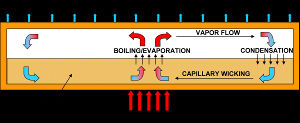Communications of the ACM
Nanowick at Heart of New System to Cool 'power Electronics'
Purdue University researchers have developed an advanced cooling technology that can handle about 10 times the heat generated by conventional computer chips. The technology consists of a miniature, lightweight device made of tiny copper spheres and carbon nanotubes that passively wick a coolant toward hot electronics, says Purdue professor Suresh V. Garimella.
 This diagram depicts a cooling device called a heatpipe, used in electronics and computers. Researchersare developing an advanced type of heat pipe forhigh-power electonics in military and automotiveapplications.Credit: School of Mechanical Engineering, Purdue University This diagram depicts a cooling device called a heatpipe, used in electronics and computers. Researchersare developing an advanced type of heat pipe forhigh-power electonics in military and automotiveapplications.Credit: School of Mechanical Engineering, Purdue University |
The system works by circulating water through a boiling, evaporating, and condensing process. Allowing a liquid to boil significantly increases how much heat can be removed compared with heating a liquid to temperatures below its boiling point.
From Purdue University News
View Full Article
Abstracts Copyright © 2010 Information Inc., Bethesda, Maryland, USA 
No entries found